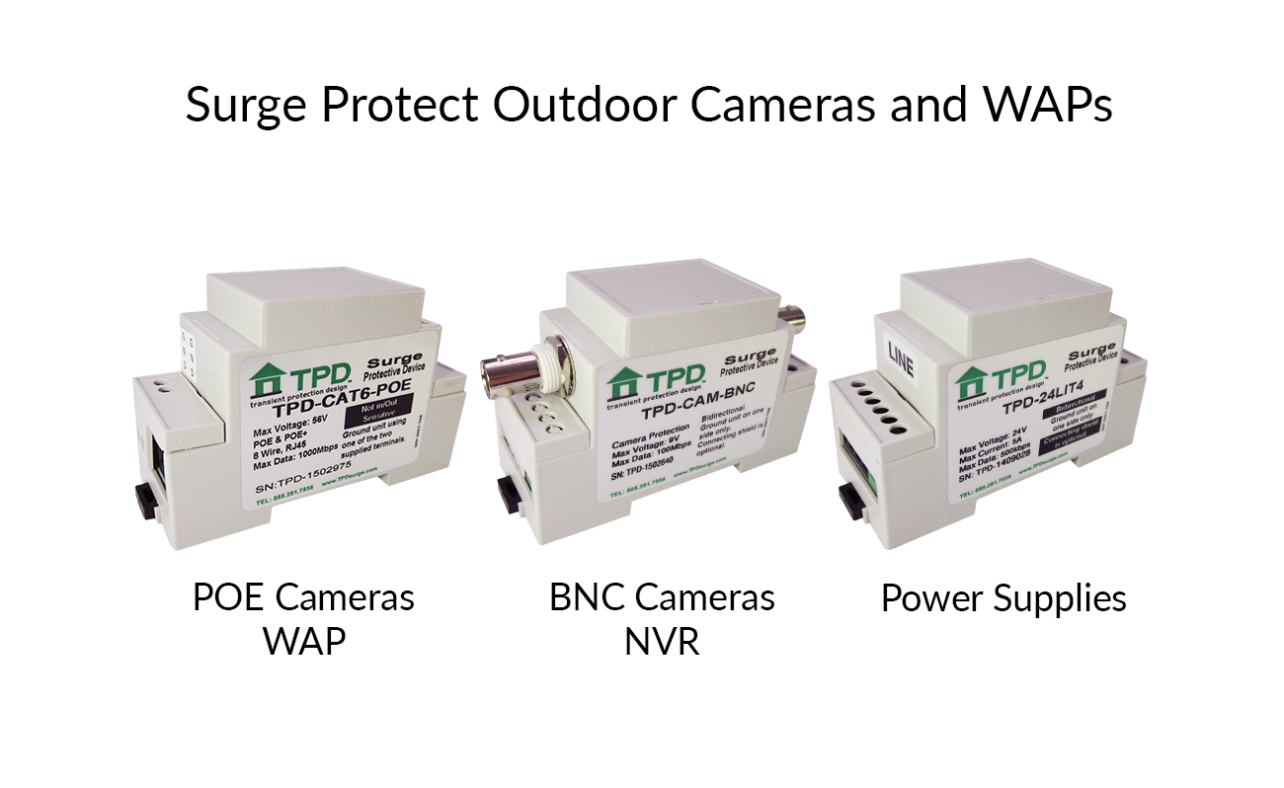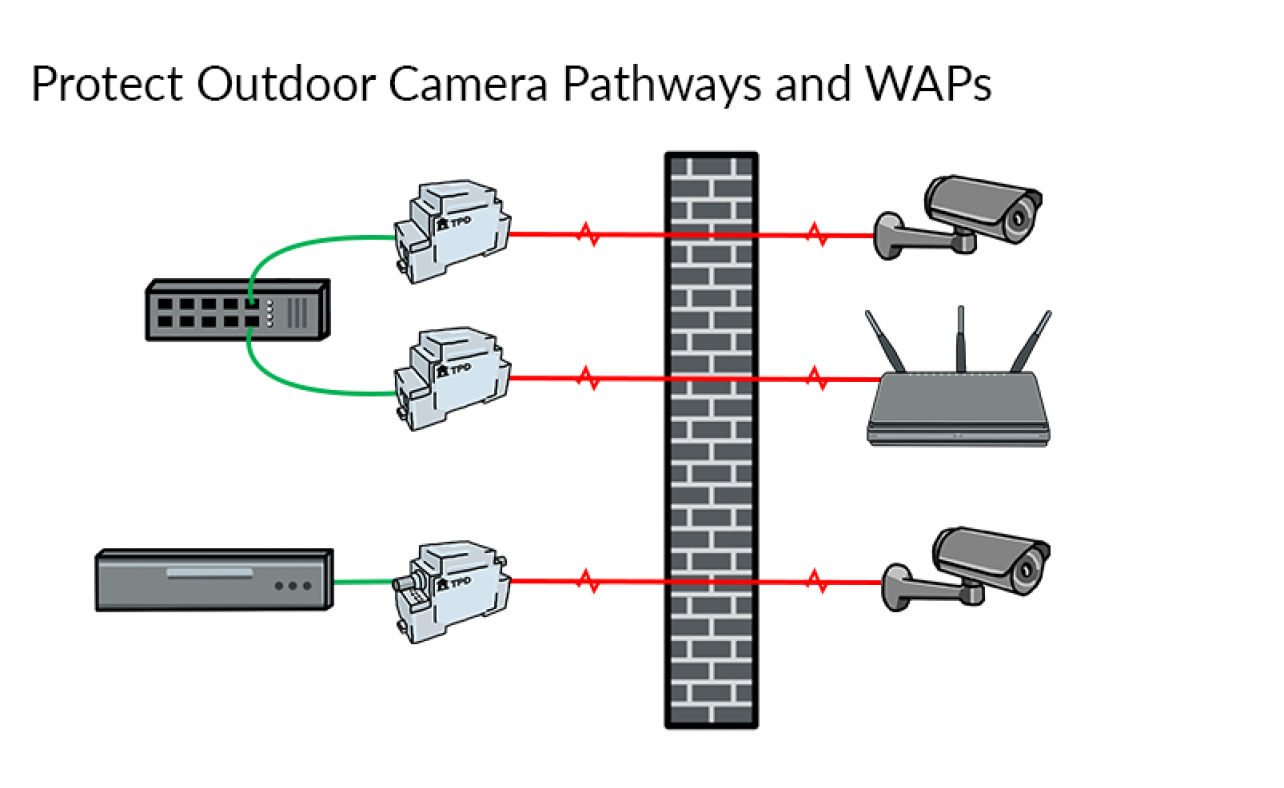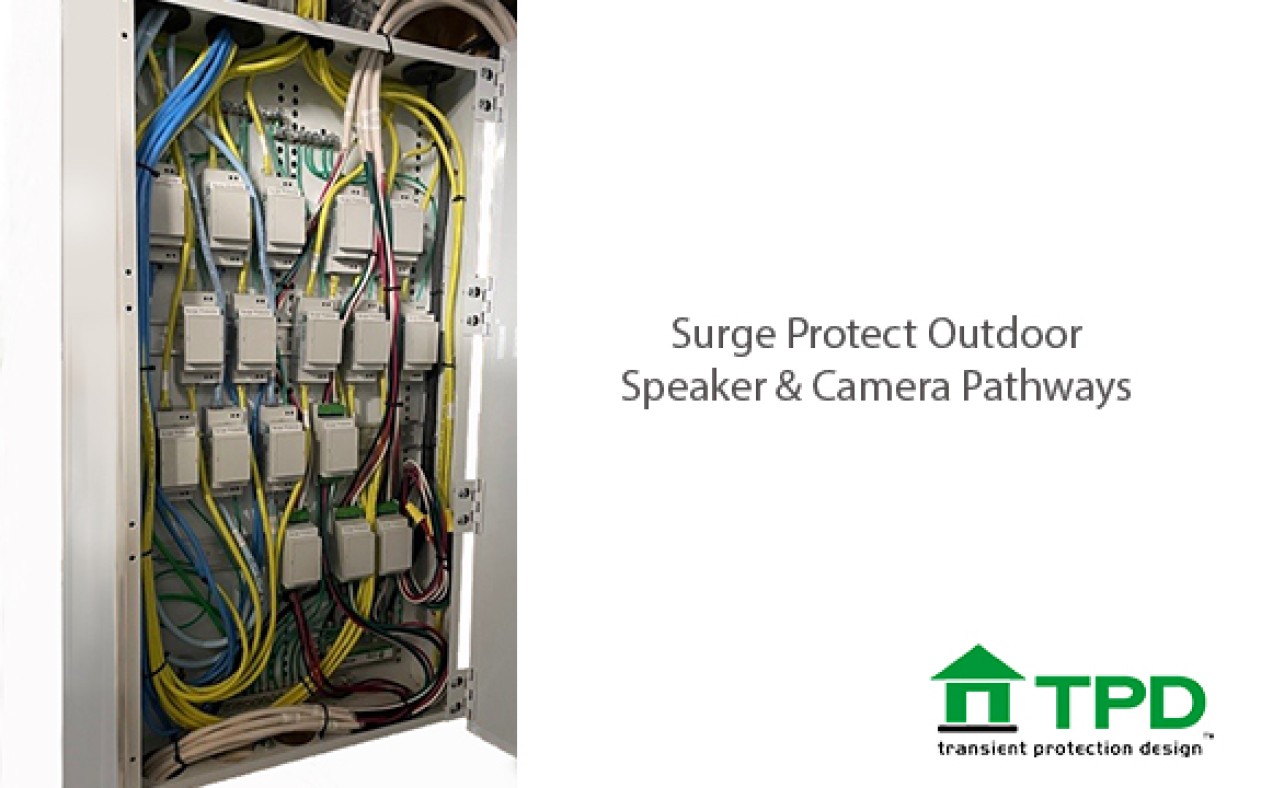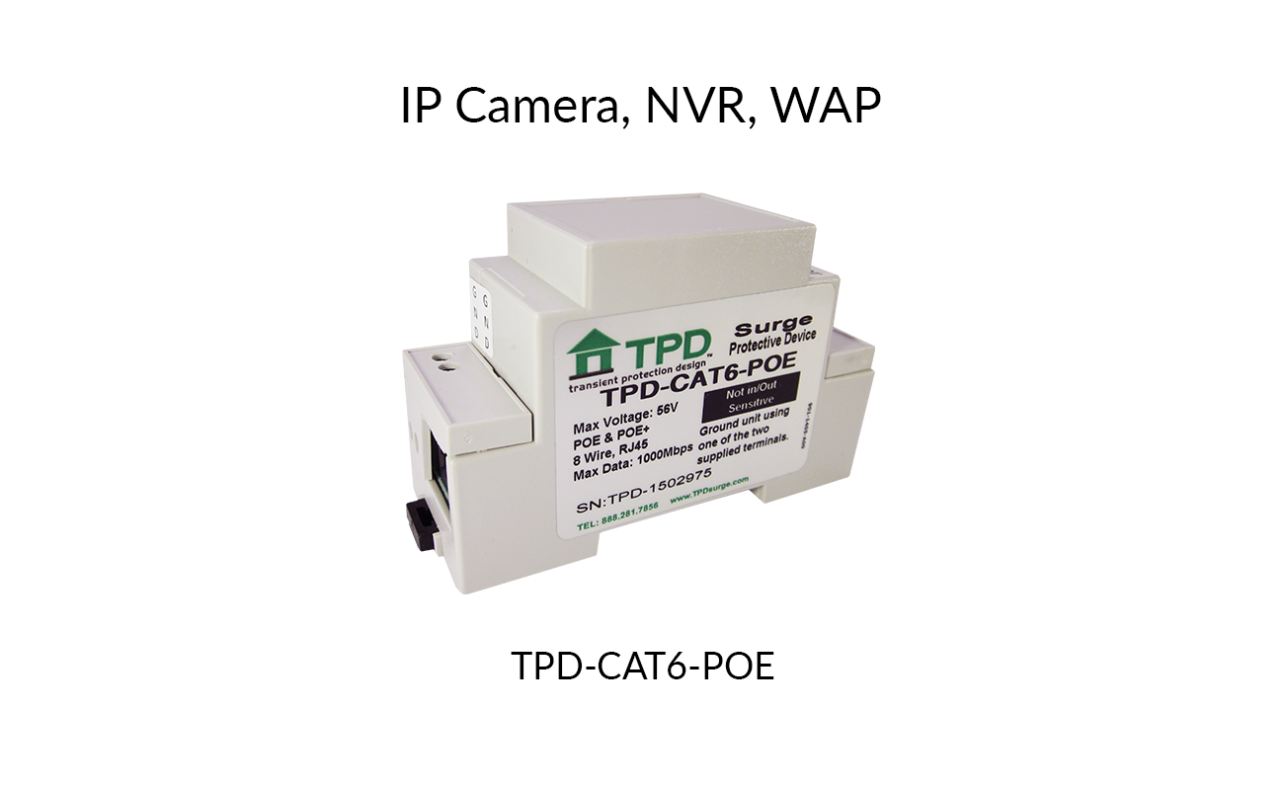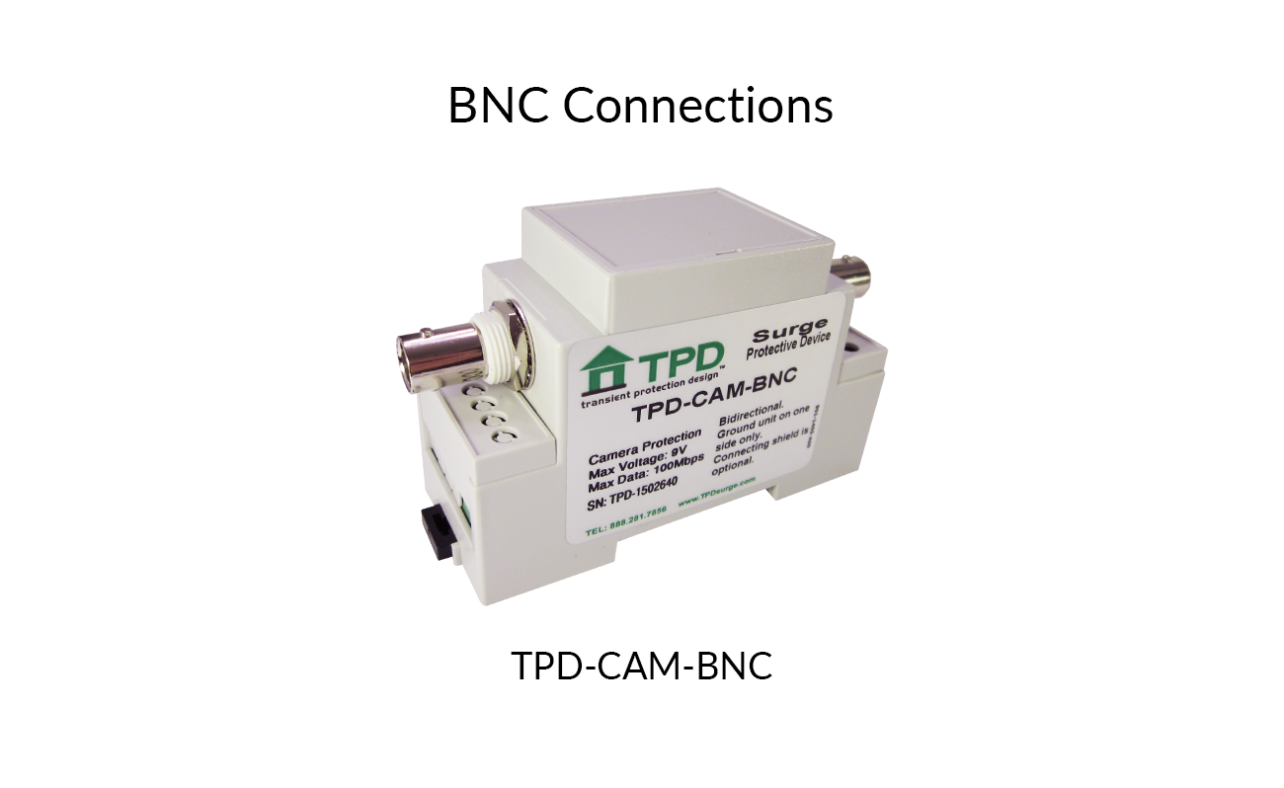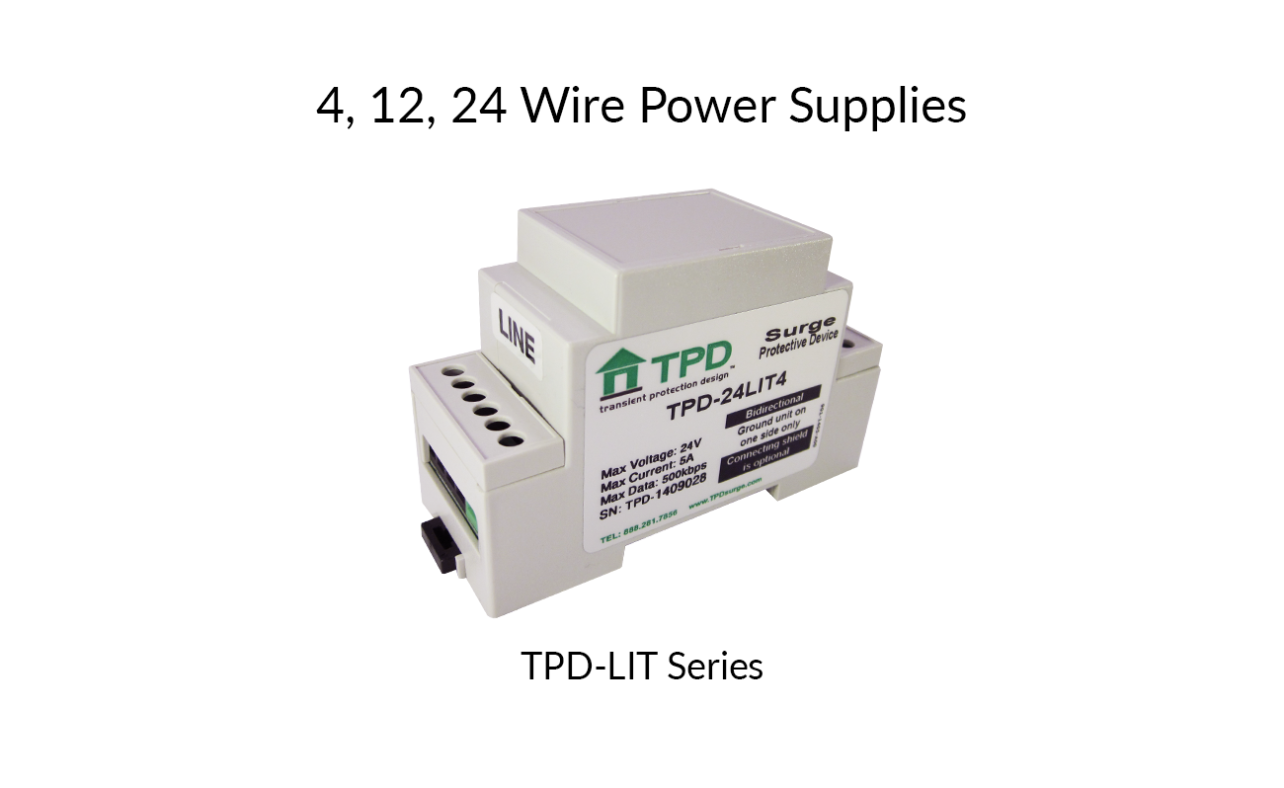Outdoor Camera and WAP Surge Protection
Outdoor camera and WAP surge protection and their pathways back to your building’s network is crucial for keeping security and surveillance systems running and protecting what matters. Any equipment installed outdoors serves as a potential entry point for lightning strikes into your system, making pathway protection a top priority. With TPD surge protection, you can rest assured that damaging surges and lightning strikes won’t infiltrate your network and wreak havoc throughout your systems.
TPD-CAT6-POE IP Camera, WAP
TPD-CAM-BNC BNC Connections, NVR
TPD-24LIT4 4 Wire Power Supply
TPD-24LIT12 12 Wire Power Supply
TPD-24LIT24 24 Wire Power Supply
TPD eliminates transients & surges
which account for 85% to 95% of all
power issues, being the most common
and significantly the most damaging.
How to Surge Protect IP Cameras, NVRs, WAPs and Pathways Back into the Building
POE Cameras: TPD-CAT6-POE
For outdoor PoE camera pathways, install the TPD-CAT6-POE at the network switch to protect the building’s internal network equipment. This is the most critical protection point, as surge energy entering on the Ethernet cable will otherwise propagate directly into switches, NVRs, and other networked devices.
Best practices recommend floating cameras in the field, meaning the camera should not be bonded to local earth or mounted directly to conductive, grounded structures. Break metal-to-metal connections between poles and camera housings whenever possible. Lightning and surge energy travel on grounding paths, and improper bonding at the camera location can introduce ground potential differences that drive surge energy back toward the building.
If protection is required at the remote camera end, a second TPD-CAT6-POE may be installed at the camera, provided it is mounted inside a weatherproof enclosure. Grounding for this device must be derived from the building grounding system or originating source, not from a local ground rod at the camera. This ensures the camera, cabling, and network rise and fall together during a surge event. Avoid creating multiple grounds. Extra local grounds introduce dangerous ground-loop surges.
BNC Cameras: TPD-CAM-BNC
Install the TPD-CAM-BNC inline at the point where the coaxial cable enters the building or connects to the DVR or recording equipment. This prevents surge energy induced onto outdoor coax runs from reaching sensitive electronics inside the structure. As with IP cameras, outdoor BNC cameras should be treated as floating devices whenever possible, avoiding unnecessary bonding to local earth or grounded metal structures. Improper grounding of coax shields is a common cause of repeated camera and recorder failures.
WAPs: TPD-CAT6-POE
Install the TPD-CAT6-POE at the PoE switch or injector feeding the wireless access point. Outdoor WAPs are often mounted on rooftops, poles, and exterior walls, making them highly exposed to lightning-induced surges that travel back into the network on ethernet cabling.
Outdoor WAPs should be electrically isolated from local grounding sources whenever possible. Mounting directly to grounded metal surfaces or bonding to local earth can create multiple ground reference points, increasing the likelihood of surge energy traveling back into the building. When protection at the WAP itself is required, a TPD-CAT6-POE may be installed at the device end, housed in a weatherproof enclosure. Grounding should be extended from the building or source grounding system, ensuring the ethernet pathway, WAP, and network equipment remain at the same electrical potential during surge events.
Power Supplies: TPD-24LIT4, TPD-24LIT12, TPD-24LIT24
How It Works
Outdoor cameras and wireless access points are some of the easiest devices to surge protect, yet some of the most misunderstood. Lightning does not need to strike a camera, pole, or building directly to cause damage. Nearby strikes induce surge energy onto long copper wire runs, and that energy travels inward toward the building’s electrical grounding system. Because the building ground is typically the largest ground reference point, surge energy almost always travels from the outdoor device back into the network, not the other way around. A single unprotected outdoor camera or WAP can damage an entire switch, NVR, or network segment. For this reason, head-end protection is the correct starting point for nearly all residential and commercial projects.
Applications and Common Problems Solved
Entry Security, Gates and Fences
Gates and fence lines are major lightning exposure points. These installations often include long CAT6 runs from the home or building network to the gate, cameras mounted to metal gate posts or fences, and PoE switches or injectors located at or near the gate. Without proper pathway surge protection, these systems frequently experience repeated failures.
Hospital Parking Garages
Hospitals rely on parking garage cameras for safety, liability, and access control, making uptime critical. In these environments, protection is sometimes applied at both ends of the pathway. At the camera end, non-metallic poly enclosures are used to prevent introducing new ground potentials. Protectors are not grounded locally; instead, a grounding conductor is pulled from inside the building so all equipment references a single grounding point. This eliminates ground-loop surges and protects patient areas, staff access points, and network infrastructure.
Home with 16 Cameras
A homeowner contacted us after repeatedly losing only one or two cameras in a 16-camera system. The failed cameras were located at the front gate and rear fence post, the two longest outdoor cable runs mounted to metal structures. These runs acted like antennas, coupling lightning-induced energy onto the cable and sending it toward the house. Installing TPD surge protection at the head end stopped the failures and protected the home’s internal network.
University with 160 Cameras on Metal Poles
One of the most memorable cases involved 160 outdoor cameras mounted on 160 metal poles. To address repeated failures, local ground rods were installed at each pole, making the problem worse. The additional grounds created multiple ground potentials and destructive ground-loop pathways. The solution was removing unnecessary local grounds, isolating the camera mounts from the poles, and installing surge protection at the head end. Once corrected, the failures stopped entirely. See our page on Ground Loop Surge Filters for more information on how to protect electronics from damaging ground loops and surges.
Codes, Standards, and Industry Guidance
The National Electric Code (NEC) addresses requirements for communications system surge protection and bonding.
NEC Article 800
Addresses ethernet cabling used for IP cameras and WAPs. It requires communications systems entering a building to be bonded to the building grounding electrode system to reduce voltage differences and limit damage from lightning-induced surges.
NEC Article 725
PoE-powered cameras and wireless access points are also considered Class 2 or Class 3 power-limited circuits. When these circuits are routed outdoors or leave the building envelope, they are more susceptible to induced transient energy, making proper pathway protection and bonding critical to system reliability.
NEC Article 250
Addresses grounding and bonding practices. This emphasizes a single grounding reference and the avoidance of objectionable current paths. Installing local ground rods at remote camera poles, gates, or fence lines often creates multiple ground potentials and ground-loop pathways, increasing the likelihood of equipment damage rather than reducing it.
NEC Article 820
Addresses grounding and bonding practices of coaxial and outside signal conductors in analog and BNC-based camera systems.
While the NEC does not mandate specific low-voltage surge protection devices for cameras or WAPs, these articles establish the intent to control surge energy at the building entry point and prevent damage to connected equipment.
The Importance of Outdoor Camera and WAP Surge Protection
Preserve Data Integrity
Security camera data pathways are the backbone of surveillance, capturing critical video footage for monitoring and analysis. TPD surge protection shields against electrical damage, ensuring the integrity of surveillance data. Whether it's safeguarding your home or a commercial property, surge protection preserves the clarity and reliability of recorded footage.
Protect Valuable Equipment
Surveillance systems consist of valuable components, including cameras, recorders, and data storage devices. Surge-induced damage can lead to costly repairs or replacements of these components. TPD surge protection serves as a guardian, reducing the risk of electrical damage and extending the lifespan of your surveillance equipment in both residential and commercial applications.
Continuous Security Monitoring
In both residential and commercial environments, a disruption in security camera data pathways can leave properties vulnerable to security breaches. Residential users rely on surveillance for home safety, while businesses depend on it for asset protection and personnel security. TPD surge protection improves the reliability of security monitoring, fortifying security measures in both contexts.
Cost Savings
Repairing or replacing surveillance equipment can be financially burdensome. TPD surge protection acts as a financial barrier against electrical damage, mitigating the risk of unexpected repair expenses. Whether it's safeguarding your home or securing a commercial property, TPD surge protection contributes to cost savings.
Operational Continuity
In commercial settings, security camera systems are integral to various operations, including access control, incident management, and compliance. Surge-induced failures can disrupt business activities, impacting productivity and security. Security camera data pathway surge protection plays a pivotal role in maintaining operational continuity, ensuring seamless security monitoring for both businesses and clients.
Safety and Compliance
Compliance with industry standards and ensuring the reliability of surveillance evidence is paramount in both residential and commercial security setups. TPD surge protection helps meet these requirements, ensuring that surveillance systems perform reliably and adhere to industry standards. It ensures the credibility and admissibility of surveillance data in legal and compliance scenarios.
TPD surge protection for security camera data pathways is imperative for preserving data integrity, protecting valuable equipment, maintaining uninterrupted security monitoring, achieving cost-efficiency, ensuring operational continuity, and meeting industry standards in both residential and commercial applications. It provides peace of mind, reliability, and data security for homeowners and businesses alike, ensuring that every frame of surveillance data is clear, reliable, and free from disruptions.

